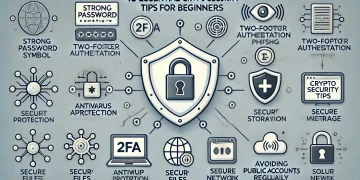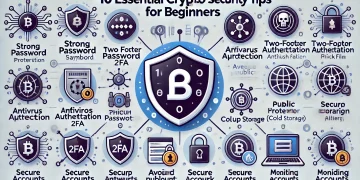Table of Contents
- Introduction
- Understanding Cryptocurrency Markets
- Essential Tools for Cryptocurrency Trading
- Fundamental Analysis in Cryptocurrency Trading
- Technical Analysis for Cryptocurrencies
- Proven Trading Strategies for Beginners
- Risk Management in Cryptocurrency Trading
- Common Mistakes to Avoid
- Developing Your Own Trading Plan
- Staying Informed: Resources for Continuous Learning
- Legal and Tax Considerations
- Conclusion
Introduction
Cryptocurrency trading has become increasingly popular in recent years, attracting both seasoned investors and newcomers alike. The volatile nature of the crypto market offers unique opportunities for profit, but it also comes with significant risks. This comprehensive guide aims to equip beginners with proven strategies to navigate the complex world of cryptocurrency trading.
Whether you’re drawn to crypto trading for its potential returns, technological innovation, or simply out of curiosity, this guide will provide you with a solid foundation to start your trading journey. We’ll cover everything from understanding market dynamics and essential tools to specific trading strategies and risk management techniques.
It’s important to note that while these strategies have proven effective for many traders, cryptocurrency trading inherently carries risks. This guide will help you make informed decisions and develop a disciplined approach to trading, but it’s crucial to only invest what you can afford to lose and to continue educating yourself beyond this guide.
Understanding Cryptocurrency Markets
Before diving into specific trading strategies, it’s essential to understand the unique characteristics of cryptocurrency markets.
Market Dynamics
Cryptocurrency markets operate differently from traditional financial markets in several key ways:
- 24/7 Trading: Unlike stock markets, crypto markets never close, allowing for round-the-clock trading.
- High Volatility: Crypto prices can experience significant fluctuations in short periods, offering both opportunities and risks.
- Global and Decentralized: Crypto markets are not tied to any single country or institution, making them less susceptible to localized events but more reactive to global trends.
- Influence of News and Social Media: Crypto prices can be highly sensitive to news events, regulatory changes, and even social media trends.
- Varying Liquidity: While major cryptocurrencies like Bitcoin and Ethereum have high liquidity, smaller altcoins may have lower trading volumes, affecting price stability.
Key Terms and Concepts
Familiarize yourself with these essential terms:
- Bull Market: A market characterized by rising prices and optimistic sentiment.
- Bear Market: A market characterized by falling prices and pessimistic sentiment.
- FOMO: Fear of Missing Out, often driving impulsive buying decisions.
- FUD: Fear, Uncertainty, and Doubt, often causing panic selling.
- Altcoin: Any cryptocurrency other than Bitcoin.
- Market Cap: The total value of a cryptocurrency, calculated by multiplying the current price by the circulating supply.
- Volume: The amount of cryptocurrency traded during a specific period.
- Leverage: Borrowing funds to increase the potential return of an investment.
- Liquidation: Forced closure of a leveraged position due to insufficient funds to maintain the position.
Essential Tools for Cryptocurrency Trading
To start trading cryptocurrencies, you’ll need access to several key tools and platforms.
Cryptocurrency Exchanges
Exchanges are platforms where you can buy, sell, and trade cryptocurrencies. Some popular options include:
- Coinbase: User-friendly, suitable for beginners, but with higher fees.
- Binance: Offers a wide range of cryptocurrencies and advanced trading features.
- Kraken: Known for its strong security measures and advanced trading options.
- Gemini: Emphasizes regulatory compliance and security.
When choosing an exchange, consider factors like:
- Security measures
- Available cryptocurrencies
- Trading fees
- User interface
- Regulatory compliance
Wallets
Wallets are essential for storing your cryptocurrencies securely. Types of wallets include:
- Hardware Wallets: Physical devices that store your crypto offline (e.g., Ledger, Trezor).
- Software Wallets: Desktop or mobile applications (e.g., Exodus, MyEtherWallet).
- Paper Wallets: Physical documents containing your private keys.
- Exchange Wallets: Provided by exchanges, convenient but less secure than personal wallets.
For long-term storage, hardware wallets are generally considered the most secure option.
Trading and Analysis Tools
These tools can help you make informed trading decisions:
- TradingView: Offers advanced charting tools and a social network for traders.
- CoinMarketCap: Provides market data, including prices, volume, and market capitalization.
- CryptoCompare: Offers price comparisons across exchanges and portfolio tracking.
- Coinigy: A platform that integrates with multiple exchanges for trading and analysis.
Fundamental Analysis in Cryptocurrency Trading
Fundamental analysis involves evaluating a cryptocurrency’s intrinsic value based on various factors:
- Team and Leadership: Assess the experience and credibility of the project’s team.
- Technology and Innovation: Evaluate the uniqueness and potential impact of the project’s technology.
- Adoption and Partnerships: Look for signs of real-world adoption and significant partnerships.
- Market Position and Competition: Consider the project’s standing relative to competitors.
- Tokenomics: Understand the cryptocurrency’s supply mechanics and distribution.
- Community and Development Activity: Active communities and ongoing development are positive signs.
- Regulatory Environment: Consider how regulations might affect the project’s future.
Technical Analysis for Cryptocurrencies
Technical analysis involves studying price charts and using indicators to identify trends and make trading decisions. Key concepts include:
- Candlestick Charts: Visual representations of price movements over time.
- Support and Resistance Levels: Price levels where a cryptocurrency tends to stop falling or rising.
- Moving Averages: Indicators that smooth out price data to identify trends.
- Relative Strength Index (RSI): Measures the speed and change of price movements.
- Bollinger Bands: Indicate volatility and potential overbought or oversold conditions.
While technical analysis can be complex, starting with these basic concepts can help you make more informed trading decisions.
Proven Trading Strategies for Beginners
Here are five proven strategies suitable for beginners in cryptocurrency trading:
Strategy 1: Dollar-Cost Averaging (DCA)
DCA involves investing a fixed amount of money at regular intervals, regardless of the market price.
How it works:
- Choose a cryptocurrency you believe in long-term.
- Decide on a fixed amount you can invest regularly (e.g., $100 per week).
- Set up automatic purchases at your chosen interval.
Pros:
- Reduces the impact of volatility
- Removes emotional decision-making
- Suitable for long-term investors
Cons:
- May miss out on opportunities to buy large amounts at low prices
- Requires discipline and consistency
Strategy 2: HODLing
HODL (Hold On for Dear Life) is a long-term investment strategy involving buying and holding cryptocurrencies for an extended period.
How it works:
- Research and select cryptocurrencies with strong fundamentals.
- Purchase your chosen cryptocurrencies.
- Store them securely, ideally in a hardware wallet.
- Hold onto your investments regardless of short-term price fluctuations.
Pros:
- Simple strategy suitable for beginners
- Potential for significant long-term gains
- Reduces stress from short-term price movements
Cons:
- Requires strong conviction and patience
- May miss out on short-term trading opportunities
Strategy 3: Swing Trading
Swing trading involves capturing ‘swings’ in crypto prices over a period of days or weeks.
How it works:
- Identify cryptocurrencies with a history of price swings.
- Use technical analysis to identify potential entry and exit points.
- Buy when the price is low and sell when it’s high, capturing the ‘swing’.
Pros:
- Can capitalize on both upward and downward price movements
- Less time-intensive than day trading
Cons:
- Requires more active management than HODLing or DCA
- Risk of missing larger trends while focusing on short-term swings
Strategy 4: Range Trading
Range trading involves identifying a cryptocurrency’s typical price range and trading within that range.
How it works:
- Identify a cryptocurrency that tends to trade within a specific price range.
- Buy near the bottom of the range and sell near the top.
- Repeat this process as long as the price continues to move within the range.
Pros:
- Can be profitable in sideways markets
- Clear entry and exit points
Cons:
- Risk of significant losses if the price breaks out of the range
- Requires careful monitoring of price movements
Strategy 5: Momentum Trading
Momentum trading involves buying cryptocurrencies that are showing strong upward trends and selling when the trend appears to be losing strength.
How it works:
- Use technical indicators like Moving Average Convergence Divergence (MACD) to identify strong trends.
- Enter a trade when a strong upward trend is identified.
- Set a stop-loss to limit potential losses.
- Exit the trade when the momentum appears to be slowing or reversing.
Pros:
- Can lead to significant profits in strongly trending markets
- Clear entry and exit signals
Cons:
- Risk of buying at the peak of a trend
- Requires quick decision-making and active management
Risk Management in Cryptocurrency Trading
Effective risk management is crucial for successful cryptocurrency trading. Here are some key principles:
- Only Invest What You Can Afford to Lose: Never risk more than you can comfortably lose.
- Use Stop-Loss Orders: Set automatic sell orders at a predetermined price to limit potential losses.
- Diversification: Don’t put all your funds into a single cryptocurrency.
- Position Sizing: Limit each trade to a small percentage of your total portfolio (e.g., 1-2%).
- Understand Leverage: If using leverage, start small and understand the risks of liquidation.
- Keep Emotions in Check: Don’t let fear or greed drive your trading decisions.
- Use Secure Practices: Enable two-factor authentication, use strong passwords, and keep most of your crypto in cold storage.
Common Mistakes to Avoid
Be aware of these common pitfalls in cryptocurrency trading:
- Chasing Pumps: Buying a cryptocurrency just because its price is rising rapidly.
- Panic Selling: Selling in a panic when prices drop sharply.
- Overtrading: Making too many trades, often driven by FOMO or impatience.
- Neglecting Research: Trading based on hype or tips without doing your own research.
- Ignoring the Bigger Picture: Focusing too much on short-term price movements and ignoring fundamental factors.
- Not Having a Plan: Trading without a clear strategy or exit plan.
- Risking Too Much: Investing more than you can afford to lose or using excessive leverage.
Developing Your Own Trading Plan
A personal trading plan is crucial for consistent and disciplined trading. Your plan should include:
- Goals: Clear, realistic trading objectives.
- Risk Tolerance: How much you’re willing to risk on each trade and overall.
- Preferred Strategies: Which trading strategies you’ll use and when.
- Entry and Exit Rules: Clear criteria for when to enter and exit trades.
- Position Sizing: How much of your portfolio you’ll allocate to each trade.
- Record Keeping: A system for tracking your trades and learning from them.
- Review and Adjustment: Regular review of your plan and adjustments based on performance.
Staying Informed: Resources for Continuous Learning
To stay updated on the fast-moving world of cryptocurrencies:
- News Websites: CoinDesk, Cointelegraph, Bitcoin Magazine
- Social Media: Follow reputable crypto analysts and projects on Twitter
- Podcasts: “Unchained,” “What Bitcoin Did,” “The Pomp Podcast”
- Books: “The Bitcoin Standard” by Saifedean Ammous, “Cryptoassets” by Chris Burniske and Jack Tatar
- Online Courses: Coursera and Udemy offer courses on blockchain and cryptocurrency trading
- Forums: Reddit communities like r/CryptoCurrency and r/BitcoinMarkets
Legal and Tax Considerations
Cryptocurrency trading has legal and tax implications that vary by jurisdiction:
- Regulatory Compliance: Ensure you’re complying with local laws regarding cryptocurrency trading.
- Tax Obligations: In many countries, cryptocurrency trades are taxable events. Keep detailed records of all your trades.
- Reporting Requirements: Some jurisdictions require reporting of cryptocurrency holdings above certain thresholds.
- Seek Professional Advice: Consult with a tax professional familiar with cryptocurrency regulations in your area.
Conclusion
Cryptocurrency trading offers exciting opportunities, but it also comes with significant risks. By understanding market dynamics, utilizing essential tools, implementing proven strategies, and practicing effective risk management, beginners can navigate this complex landscape more confidently.
Remember, the strategies outlined in this guide are starting points. As you gain experience, you’ll develop your own approach that aligns with your goals, risk tolerance, and market understanding. Continuous learning, patience, and discipline are key to long-term success in cryptocurrency trading.
Start small, practice with a paper trading account if possible, and never invest more than you can afford to lose. With time and experience, you’ll be better equipped to capitalize on the opportunities in the dynamic world of cryptocurrency trading.
Happy trading, and may your investments be profitable and your risks well-managed!






























